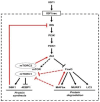An Overview of Sarcopenia: Focusing on Nutritional Treatment Approaches
- PMID: 40218995
- PMCID: PMC11990658
- DOI: 10.3390/nu17071237
An Overview of Sarcopenia: Focusing on Nutritional Treatment Approaches
Abstract
Sarcopenia is a syndrome characterized by the progressive and generalized loss of skeletal muscle mass and strength. This condition is associated with physical disability, decreased quality of life, and increased mortality. Therefore, reducing the prevalence of sarcopenia could significantly lower healthcare costs. Sarcopenia can be classified into primary and secondary sarcopenia. The former is related to aging and begins after the fourth decade of life; after that, there is a muscle loss of around 8% per decade until age 70 years, which subsequently increases to 15% per decade. On the other hand, secondary sarcopenia can affect all individuals and may result from various factors including physical inactivity, malnutrition, endocrine disorders, neurodegenerative diseases, inflammation, and cachexia. Understanding the multiple mechanisms involved in the onset and progression of sarcopenia allows for us to develop strategies that can prevent, treat, or at least mitigate muscle loss caused by increased protein breakdown. One potential treatment of sarcopenia is based on nutritional interventions, including adequate caloric and protein intake and specific nutrients that support muscle health. Such nutrients include natural food rich in whey protein and omega-3 fatty acids as well as nutritional supplements like branched-chain amino acids, β-hydroxy-β-methylbutyrate, and vitamin D along with food for special medical purposes. It is important to emphasize that physical exercises, especially resistance training, not only promote muscle protein synthesis on their own but also work synergistically with nutritional strategies to enhance their effectiveness.
Keywords: branched-chain amino acids; muscle mass; muscle strength; nutrients; omega-3 fatty acids; vitamin D; whey proteins; β-hydroxy-β-methylbutyrate.
Conflict of interest statement
The authors declare no conflicts of interest.
Figures




References
-
- Cruz-Jentoft A.J., Baeyens J.P., Bauer J., Boirie Y., Cederholm T., Landi F., Martin F.C., Michel J.P., Rolland Y., Schneider S.M., et al. European consensus on definition and diagnosis: Report of the European Working Group on Sarcopenia in Older People. Age Ageing. 2010;39:412–423. doi: 10.1093/ageing/afq034. - DOI - PMC - PubMed
Publication types
MeSH terms
Substances
LinkOut - more resources
Full Text Sources

